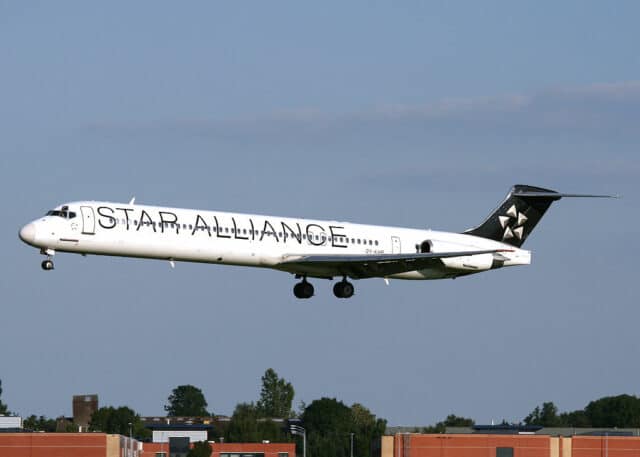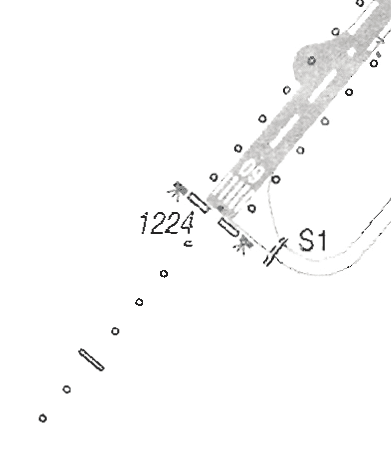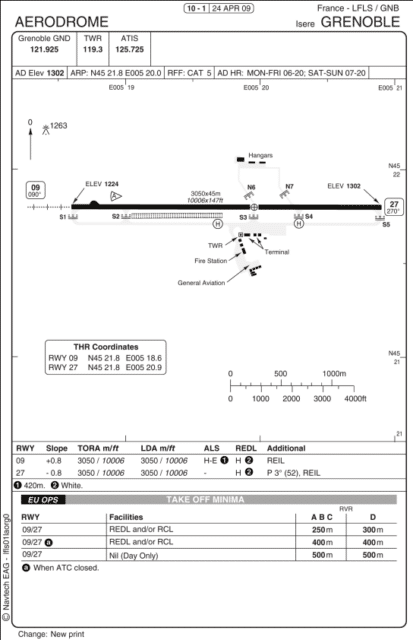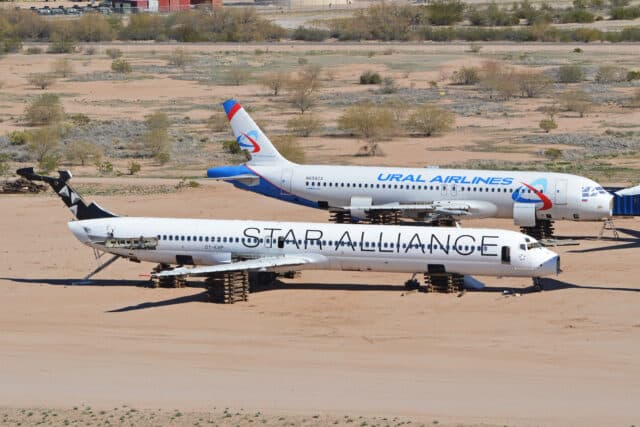The Illusion of a Perfect Landing
On the 6th of February 2010, at about half past four in the afternoon, an SAS flight took off from Copenhagen Airport for a short flight to France. Amazingly, everyone survived.
The aircraft was a McDonnell Douglas MD-81. The MD-81 is the longer variant of the MD-80: a five-abreast single-aisle airliner designed as the second-generation DC-9. This aircraft was 19 years old in 2010 and registered in Denmark as OY-KHP; SAS had named it Arild Viking. The previous aircraft of that name, a Douglas DC-6 that started service in 1952, saved about a thousand miles and four hours when it flew the route from Los Angeles to Copenhagen across the polar region; a flight that the pilot called “just a wonderful pleasure cruise” and the New York Times described as “trailblazing”.
We are all familiar with the pattern of the shrinking world. We have been told that the polar route is a natural short cut. We could expect something like this, of course. But the fact remains that achievements of this sort are not made up out of thin air or bodiless dreams. They are brought about by painstaking research and trial. They involve imagination and intrepidity. They require men.
The plane that made history was not named Viking for nothing.
This namesake MD-81 was in the process of a much less exciting flight: a passenger service from Copenhagen to Grenoble, France, with six crew and 127 passengers on board.

The two flight crew were the captain, an experienced aviator with 12,720 hours of flight, over half of which on type, and the first officer with 3,441 flying hours, of which 666 were on type. On that day, the first officer was the Pilot Flying and the captain was the Pilot Monitoring.
It was already dark on that February evening; the moon would not be rising for some hours. Conditions were visual, but there was a thin cloud cover above, hiding the stars from sight.
Grenoble-Isére aerodrome has a single runway, 09/27, which is 3,050 metres long (10,000 feet) and 45 metres wide. The runway is slightly sloped. Runway 09 has an Instrument Landing System (ILS) and a category 1 precision approach lighting system. It does not have PAPI or VASI lights to give a visual indication of the approach glide slope.
The flight crew had never landed at Grenoble before. The first officer had been on sick leave during the previous two months; stress had made him unfit. Although he was approved to return to his flying duties, a few weeks before the flight he’d been informed that he had been made redundant. That morning, he’d received a letter to confirm the details of his redundancy. His last day on the job was less than a month away.
As they started their descent, the crew referred to their chart of the aerodrome. The approach lighting at Grenoble runs 420 metres (1,380 feet), with a crossbar located 300 metres before the runway threshold. Here is the aerodrome approach as shown in the French Aeronautical Information Service.

However, the crew were using Navtech EAG chart which, for reasons that no one can really explain, showed the approach ramp as having a 900 metre approach lighting system with three crossbars.

wrongly showing the approach ramp
As the lights of the Grenoble came into view, the flight crew were surprised to see that the approach lighting did not extend as far as they had expected and had only one crossbar, not three. The flight crew contacted the Tower Controller and reported that they were established on the localiser for runway 09 at about ten nautical miles out. They confirmed that they had the runway in sight.
The MD-81 has landing lights installed on the nose wheel and retractable landing lights on the wings. A switch in the cockpit allowed the flight crew to set it, with settings of OFF, DIM or BRT (bright). It was at the discretion of the pilots as to which setting to use but most night landings were carried out with the lights set to DIM, to save wear and tear (one presumes they mean “bulbs”). The airline’s approach briefing didn’t include any consideration of what level to set the landing lights. Although the crew commented that it was extraordinarily dark that night, the landing lights were set to DIM.
So, too, were the runway and approach lights at Grenoble. Again, this was standard procedure as long as horizontal visibility was greater than 1,500 meters. That night, horizontal visibility was 9,000 meters and the flight crew had seen the airfield at ten miles out (16,000 metres).
The controller can increase the level of brightness, for example, if the horizontal visibility seems to be dropping, or if incoming flight crew request that the lights be brightened. On this evening, the controller didn’t see any need to increase the brightness and the flight crew didn’t ask.
The MD-81 descended through 1,500 feet on the ILS final approach path. Their target speed (Vapp), to be maintained until the start of the flare to land, was 137 knots. If the indicated airspeed is 10 knots above or 5 knots below Vapp, then the Pilot Monitoring should call out the variation.
The first officer, as Pilot Flying, disengaged the autopilot as they descended through 1,000 feet. The indicated airspeed was slightly high, three knots above the target speed, but the MD-81 was on the glide path and descending at a vertical speed of 700 feet per minute. Everything was unfolding exactly as it should.
At 200 feet above the runway height, the first officer disengaged the autothrottle.
Usually, on an ILS approach, the autothrottle is set to speed select mode, in which the autothrottle maintains the target speed down to 50 feet above the runway. Then the autothrottle is automatically set to RETARD and the power levers gradually return to flight idle. In a perfect approach, the power will reach flight idle just as the pilot initiates the landing flare, slightly raising the nose of the plane to slow the descent rate and position the aircraft for touching down. Once on the ground, the crew deploys the thrust reverses and the autothrottle is disengaged.
Later, the captain said he preferred to land with the autothrottle engaged, while the first officer said he often disengaged the autothrottle for landing if everything looked normal.
As the autothrottle was disengaged, the flight crew needed to manually manage the thrus , in order to maintain the target speed and reduce power to idle before the flare, typically at about 30 feet above the runway. One of the flight crew, probably the first officer, pulled back the power levers to reduce the power. They continued to descend on the 3° glide path at about 3 knots above their targeted approach speed.
Everything looked great until the aircraft was a hundred feet above the runway height. The indicated air speed began to decrease. At the same time, the rate of descent increased to 850 feet per minute. The descending aircraft continued slightly below the glide path.
At thirty feet above the runway height, at the point when the power should have been set to idle and the first officer pulling the nose up for the landing flare, the aircraft continued on a parallel trajectory below the glide path.
As the aircraft descended through 15 feet, the first officer suddenly saw the ground and tugged the yoke towards him, forcing the elevators to pitch the nose up abruptly. The pitch attitude quickly increased but they were too low to recover. The tail smashed into the ground.
They had not reached the runway, in fact, they were still over 166 metres (550 feet) from the touchdown zone.
The MD-81 settled on the ground and the flight crew quickly retarded the thrust levers and deployed the thrust reversers, successfully bringing the stricken aircraft to a halt on the runway. They were able to taxi the MD-81 to the parking ramp where the passengers were released.
Unfortunately, the flight crew did not pull the breaker for the cockpit voice recording. Maintenance crews switched the aircraft’s electrical system as needed, also without checking the breaker, and the combined time of these power-ups totaled over 30 minutes, which meant the cockpit voice recording from the flight had been erased. Although we can establish their actions through the data saved on the Flight Data Recorder, we have no information as to what was said in the cockpit.
One of the issues with spatial disorientation is that it is very difficult to prove that a pilot or pilots were responding to an illusion. However, the conditions were absolutely perfect for the black hole effect. There were no visual references between the aircraft and the runway. The moon had not yet risen and the stars were hidden under a thin veneer of cloud. Surrounded by featureless terrain, it would be difficult to discern that the runway sloped slightly. The dimmed runway lighting and the low landing lights on the nose gear meant that even as the aircraft approached the ground, it was not easy to see the unlit terrain.
In this case, it appears that on short final, the first officer and the captain both believed that the aircraft was higher above the ground that it was. The first officer corrected their trajectory, and looking out at the runway lights, they both believed that that they were now descending directly to the runway.
So strongly did the illusion hold, that neither noticed the Extended Ground Proximity Warning System calling out their height above the ground from 50 feet onwards. Not until the very last minute did they realise they were about to strike the ground as they flew over the approach lights leading to the runway.
Perhaps if the first officer had left the auto-throttle engaged, one of them would have noticed the power levers moving back automatically at 50 feet in preparation for the landing flare. But perhaps not: the danger with a visual illusion is how confident the brain is that it has interpreted the data correctly.
The Bureau d’Enquêtes et d’Analyses pour la sécurité de l’aviation civile (BEA) started an investigation which took eighteen months to conclude.
The BEA’s final report notes that by ICAO Annex 14, Grenoble Aerodrome was required to have a visual approach slope indication. If Grenoble had installed PAPI lights, the three reds shifting to four reds had a good chance of alerting the flight crew (or at least, the Captain as Pilot Monitoring) that they were not too high on approach, as they believed, but dangerously low.
The BEA’s conclusion:
The accident was due to continuing to land when the crew’s situational awareness had deteriorated. This led to an erroneous appreciation of the height in relation to the trajectory aiming point and the absence of a flare.
I feel like there is an implication here that the crew should have realised they were suffering from spatial disorientation and broken off the approach, whereas of course, the Pilot Flying had very carefully corrected the approach while under the hold of the visual illusion..
The contributing factors would have helped them to realise the situation more quickly:
The crew did not select the maximum lighting level for their landing lights; Runway 09 at Grenoble-Isère aerodrome did not have a visual approach slope indicator system; Thrust management in manual was inappropriate for the landing.
The BEA report ends with two recommendations, the first being that French aerodromes should comply with requirements for approach slope indicators (and I’d like to say, especially in the Alps!) and that the Danish Civil Aviation Administration check that their airline operators ensure that CVR recordings are preserved after accidents like this.
I don’t know if the MD-81 was repaired, but two years later, the aircraft was put into storage and used for spare parts by Delta Airlines. It now sits abandoned in the boneyard at Pinal Country in Arizona.









Even given the context of this blog, “amazingly” feels misplaced. “As expected” is what I thought here.
The dimness of the runway lights was appropriate. Quoting EASA GM1 ADR-DSN.M.615 General :
A bright light shining at you in the night makes you see less, not more. The pilots could have turned up their landing lights, however.
The accident report is in error here. The table below the aerodrome map shows the ALS for RWY 09 as H-E (1), and footnote (1) says “420m.” Its length on the map matches that. If it had 3 crossbars, these should have been at 150m, 300m, and 450m.
As the pilots had never flown into Grenoble before, the fact that the approach lighting extends only 420m and not the standard 900m for a CAT I lighting system was probably the main thing that caught them off-guard. When your ingrained routine involves doing certain steps while you’re passing the ALS, that being half as long as usual doesn’t leave you with enough time to do them.
The accident report states, “the marks left on the runway indicated a point of contact 166 metres before the touchdown zone”, so the aircraft did reach the runway. The first touchdown zone marker is 150m from the threshold, so taking the report literally, the aircraft would’ve crossed the threshold at 0 ft., not at 50 ft., and flying that much below the glide path is quite a significant deviation that ought to have been highlighted in the report. I’d rather assume a mistranslation, and expect that the aircraft touched down 166m short of the aim point, which, given the rubber marks on satellite images of the airport, is not that unusual. The problem with the approach was mainly the flubbed flare and everything that went with it.
The pilots may have not noticed being slightly below the glide path because the runway 09 at Grenoble slopes up 0.8⁰: if you are slightly below the glide path, you’d still be angled over 3⁰ with respect to the runway.
While the pilots had lost awareness of where exactly the ground was, the glide slope and the approach lights kept them pointed at it, and thankfully the MD-81 is sturdy enough to survive a 1.9g touchdown at full speed. Would the passengers still have clapped after that landing?
I wasn’t ignoring this, I just haven’t had a chance all week.
Clearly “amazingly” sounded funnier in my head than on paper :D
I want to explore the lighting issue in more detail: certainly too bright lights are not helpful but there also appears to be a correlation between dimmer lights and the black-hole illusion. I wonder if this is because the brighter lights end up highlighting the surrounding terrain? The landing lights is clearer: the view of the terrain is what caused them to realise their situation, if the lights had been brighter, they would have seen it earlier.
The issue with the approach lights is odd (which is why I included the two images) but when I looked, I couldn’t find an example of a 420m approach ramp with three crossbars. It’s not an easy thing to search on, however! I think the footnote you are referring to is the information on the ILS procedure, not on the main chart? I took that as easily not taken in once you think you already know what to expect from the aerodrome chart.
Dammit. This one is all on me. Even as I wrote it, I thought “wait, that can’t be right, there would have been a lot more damage”. I made a mental note to check and then forgot again. This is the kind of thing that Cliff would spot when proofing — I’ll have to set up more resilient systems for checking my work. That said, I agree with your conclusion, as having a touchdown zone 166 metres along the runway would normally mean there is a displaced threshold.
You can see the “420m” footnote on the image you included in your blog post that is labeled “Navtech “AERODROME” chart in force on 06/02/2010 wrongly showing the approach ramp”. It’s weird that the report got it wrong, it includes the same image.